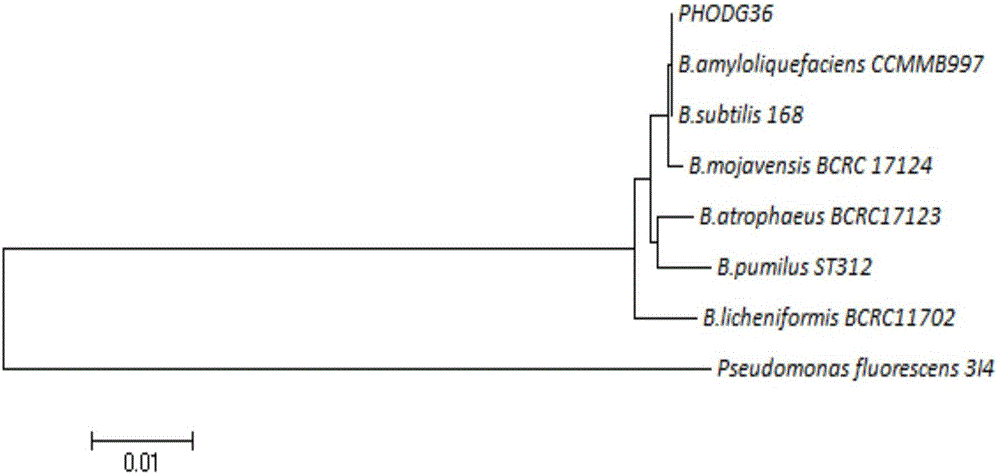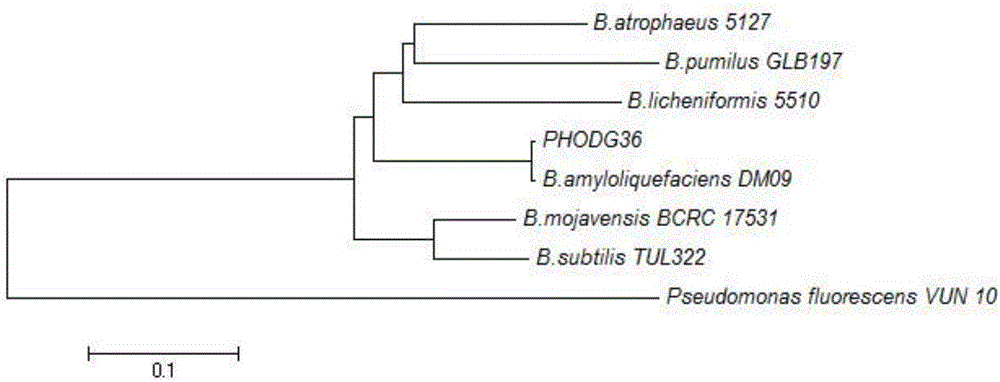Bacillus amyloliquefaciens with inorganic phosphorus degrading and bacteria restraining effects and bacterial agent thereof
A technology for dissolving starch spores and inorganic phosphorus, applied in the field of agricultural microorganisms, can solve the problems of water pollution, environmental pollution, high energy consumption, etc.
- Summary
- Abstract
- Description
- Claims
- Application Information
AI Technical Summary
Problems solved by technology
Method used
Image
Examples
Embodiment 1
[0057] The preparation of embodiment 1 bacillus amyloliquefaciens PHODG36 microbial bacterial agent
[0058] Follow the steps below:
[0059] (1) Strain activation: the Bacillus amyloliquefaciens strain PHODG36 stored at -80°C (the strain was deposited in the General Microbiology Center of the China Committee for the Collection of Microbial Cultures on September 26, 2016, and the preservation number is CGMCCNo.13041 ) on the LB plate medium (its composition and weight ratio are: tryptone 10g, yeast extract 5g, sodium chloride 5g, agar powder 15g, water 1000mL) to activate (30 ℃), pick a single colony on LB slant medium (its composition and weight ratio are: tryptone 10g, yeast extract 5g, sodium chloride 5g, agar powder 15g, water 1000mL) was cultivated at 30°C for 12 hours to obtain an activated bacterial strain;
[0060] (2) Preparation of seed liquid: make LB liquid medium according to conventional methods (its composition and weight ratio are: tryptone 10g, yeast extract ...
Embodiment 2
[0063] Embodiment 2 Bacillus amyloliquefaciens PHODG36 degrades inorganic phosphorus qualitative test
[0064] Proceed as follows:
[0065] The bacterial strain PHODG36 activated in the embodiment 1 step (1) is spot-inoculated on the solution inorganic phosphorus plate culture medium (its composition and its weight ratio are: glucose 10.0g, (NH) with sterilized toothpick 4 ) 2 SO 4 0.5g, MgSO 4 ·7H 2 O 0.5g, NaCl 0.2g, Ca 3 (PO 4 ) 2 5.0g, KCl 0.2g, MnSO 4 0.03g, FeSO 4 0.003g, 20.0g agar, 1000mL distilled water, pH: 7.0-8.0), placed in a constant temperature incubator at 30°C for 5 days, and measured the diameter of the transparent circle and the diameter of the colony.
[0066] Results Bacillus amyloliquefaciens PHODG36 contained Ca 3 (PO 4 ) 2 A transparent circle with a diameter of 12.0 mm was produced on the inorganic phosphorus plate medium, indicating that Bacillus amyloliquefaciens PHODG36 can well degrade inorganic phosphorus Ca 3 (PO 4 ) 2 , has th...
Embodiment 3
[0067] Example 3 Quantitative Determination Test of Bacillus amyloliquefaciens PHODG36 Degradation Inorganic Phosphorus Ability
[0068] This experiment was carried out in the Plant Disease Biological Control Laboratory of the Institute of Plant Protection, Hebei Academy of Agriculture and Forestry Sciences in early August 2015. Proceed as follows:
[0069] (1) Preparation of fermentation medium: 10.0 g of glucose, (NH 4 ) 2 SO 4 0.5g, MgSO 4 ·7H 2 O0.5g, NaCl 0.2g, Ca 3 (PO 4 ) 2 5.0g, KCl 0.2g, MnSO 4 0.03g, FeSO 4 0.003g was added to 1000mL of distilled water, and mixed evenly to obtain a fermentation medium (pH: 7.0-8.0). Put 50 mL of fermentation medium into a 300 mL Erlenmeyer flask, and sterilize under high temperature and high pressure.
[0070] (2) Fermentation broth preparation: the PHODG36 bacterial strain seed liquid and the blank control culture fluid (the LB liquid culture medium that does not inoculate the PHODG36 bacterial strain) of embodiment 1...
PUM
 Login to View More
Login to View More Abstract
Description
Claims
Application Information
 Login to View More
Login to View More - R&D
- Intellectual Property
- Life Sciences
- Materials
- Tech Scout
- Unparalleled Data Quality
- Higher Quality Content
- 60% Fewer Hallucinations
Browse by: Latest US Patents, China's latest patents, Technical Efficacy Thesaurus, Application Domain, Technology Topic, Popular Technical Reports.
© 2025 PatSnap. All rights reserved.Legal|Privacy policy|Modern Slavery Act Transparency Statement|Sitemap|About US| Contact US: help@patsnap.com



